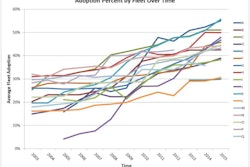The EPA and DOT’s National Highway Traffic Safety Administration (NHTSA) released their next round of greenhouse gas emissions and fuel economy standards for medium- and heavy-duty vehicles on Tuesday.
The new Phase 2 regulations, which will stack on top of the current Phase 1 standards in place today, will begin taking effect in model year (MY) 2018 with regulations for trailers, and will conclude in MY 2027.
The new rule includes NHTSA fuel consumption standards and EPA carbon dioxide (CO2) emission standards tailored to each of four regulatory categories of heavy-duty vehicles: combination tractors; trailers used in combination with those tractors; heavy-duty pickup trucks and vans; and vocational vehicles.
The EPA says the regulations will ultimately lower CO2 emissions by nearly 1.1 billion metric tons and save vehicle owners about $170 billion in fuel costs over the life of the program. When fully phased in in 2027, tractors in a tractor-trailer combination will be required to achieve up to 25 percent lower CO2 emissions and fuel consumption than an equivalent tractor in 2018.
The rule also includes separate standards for the engines that power combination tractors and vocational vehicles, and certain requirements for control of GHG emissions are exclusive to the EPA program. These include EPA’s hydrofluorocarbon standards to control leakage from air conditioning systems in vocational vehicles and EPA’s nitrous oxide (N2O) and methane (CH4) standards for heavy-duty engines.
For more information regarding the final rule and Phase 2’s rollout in the industry, please check out our sister site Successful Dealer.
To read the 1,690 page final rule, please CLICK HERE.










